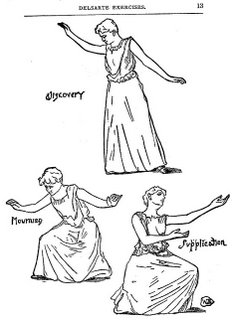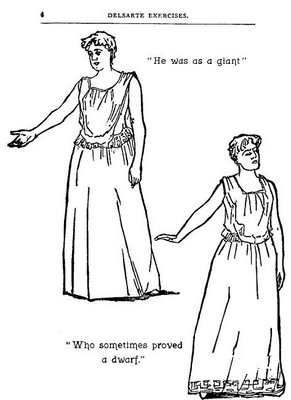 I just re-read one of the Delsarte acting posts I put up months ago. Gee, I didn't do a very good job of explaining it.
I just re-read one of the Delsarte acting posts I put up months ago. Gee, I didn't do a very good job of explaining it. Let me try again, using my own words and my own sketches this time.
Delsarte believed that certain movements are highly symbolic and powerful. When you're happy you want to throw your arms up in the air. When you're sad you want to put your head down and slump forward. Probably everybody in the world recognizes and uses these gestures...everybody except actors.
Delsarte believed that actors avoid these obvious gestures because they seem too over-the-top, too caricatured. He thought that was a pity because no other gestures convey so much power. He created a system for using gestures like these without looking ridiculous.
In the sketches above, drawing A is a watered down version of the gesture that's full strength in drawing B. The second has a lot more power, especially when seen from the side, but it might be too strong for some scenes. Delsarte says, use the broad gesture anyway, but do it at an angle that would flatten it a bit from the audience's point of view, as in drawing C. Interesting, huh?

Delsarte wanted to bring broad gestures like the one on the left above, back to acting. Of course extended arm poses aren't the only type of broad action he was interested in. The guy on the right doesn't simply talk to his friend to get his attention, he grabs his arm before speaking. That conveys to the audience that what the speaker's saying is important. The arm grab's a powerful symbol and Delsarte wonders why we don't use it.

Sometimes a gesture combines two powerful symbols. Here's (above) a gesture indicating strong emotion that ends with a strong but unexpected "come hither" gesture.




 I just re-read one of the Delsarte acting posts I put up months ago. Gee, I didn't do a very good job of explaining it. Let me try again, using my own words and my own sketches this time.
I just re-read one of the Delsarte acting posts I put up months ago. Gee, I didn't do a very good job of explaining it. Let me try again, using my own words and my own sketches this time. Delsarte wanted to bring broad gestures like the one on the left above, back to acting. Of course extended arm poses aren't the only type of broad action he was interested in. The guy on the right doesn't simply talk to his friend to get his attention, he grabs his arm before speaking. That conveys to the audience that what the speaker's saying is important. The arm grab's a powerful symbol and Delsarte wonders why we don't use it.
Delsarte wanted to bring broad gestures like the one on the left above, back to acting. Of course extended arm poses aren't the only type of broad action he was interested in. The guy on the right doesn't simply talk to his friend to get his attention, he grabs his arm before speaking. That conveys to the audience that what the speaker's saying is important. The arm grab's a powerful symbol and Delsarte wonders why we don't use it. Readers who hated the last post I did about Delsarte will probably hate this one too. It's a hard sell to convince people that Delsarte's old-fashioned "tie-the-pretty-girl-to-the railroad-tracks" school of acting is actually worth studying.
Readers who hated the last post I did about Delsarte will probably hate this one too. It's a hard sell to convince people that Delsarte's old-fashioned "tie-the-pretty-girl-to-the railroad-tracks" school of acting is actually worth studying. Here's the picture (above) I posted a few days ago. Look at it closely. The woman refers to the man as a giant, yet she's looking down and her hand is at waist-level. Why isn't her hand way up? She should be pointing up to the sky, shouldn't she? The guy's a giant after all. When she says he acted like a dwarf she looks upward disdainfully. What's going on? How come at the mention of "dwarf" she looks up, where she didn't at the mention of "giant?" Why is the orator defeating our expectations? Why don't her expressions and attitudes describe what's happening in the dialogue?
Here's the picture (above) I posted a few days ago. Look at it closely. The woman refers to the man as a giant, yet she's looking down and her hand is at waist-level. Why isn't her hand way up? She should be pointing up to the sky, shouldn't she? The guy's a giant after all. When she says he acted like a dwarf she looks upward disdainfully. What's going on? How come at the mention of "dwarf" she looks up, where she didn't at the mention of "giant?" Why is the orator defeating our expectations? Why don't her expressions and attitudes describe what's happening in the dialogue? Delsarte is full of ideas like this. How about the one where he says gesture should always preceed dialogue? Or repeated expressions of the same thought should always be identical? Or never dwell on the final word? Or geture should always be choreographed? Or...well, you see what I mean. It doesn't matter if the man is right. What's important is that he stimulates our imaginaton!
Delsarte is full of ideas like this. How about the one where he says gesture should always preceed dialogue? Or repeated expressions of the same thought should always be identical? Or never dwell on the final word? Or geture should always be choreographed? Or...well, you see what I mean. It doesn't matter if the man is right. What's important is that he stimulates our imaginaton!
 A while back I talked about Laban's theories of gesture. Maybe I should give equal time to gesturist I like a lot better: Francois Delsarte. Delsarte was the 19th century theoritician who came up with the over-the-top acting style you see in some silent films, the ones where the poor old lady is thrown out of her house by the evil, black-caped landlord. The technique is so old-fashioned and so funny-looking that our entire modern theory of acting exists to refute and bury it. That's too bad because nothing better has ever been invented.
A while back I talked about Laban's theories of gesture. Maybe I should give equal time to gesturist I like a lot better: Francois Delsarte. Delsarte was the 19th century theoritician who came up with the over-the-top acting style you see in some silent films, the ones where the poor old lady is thrown out of her house by the evil, black-caped landlord. The technique is so old-fashioned and so funny-looking that our entire modern theory of acting exists to refute and bury it. That's too bad because nothing better has ever been invented. I'm not saying that we should throw out all the great performances of the last 100+ years and go back to stylized caricature. What I'm saying is that we should keep what was of value in Delsarte: strong sillouettes, an emphasis on style that seems real rather than realism, and acting with the whole body rather than the face where it's appropriate.
I'm not saying that we should throw out all the great performances of the last 100+ years and go back to stylized caricature. What I'm saying is that we should keep what was of value in Delsarte: strong sillouettes, an emphasis on style that seems real rather than realism, and acting with the whole body rather than the face where it's appropriate. If you think Delsarte was only studied by campy, second-rate actors, think again. Among his advocates were dancerIsadora Duncan and fundamentalist preacher Billy Sunday (above and below). I'd like to add Lawrence Olivier but that's a guess and I haven't read it anywhere.
If you think Delsarte was only studied by campy, second-rate actors, think again. Among his advocates were dancerIsadora Duncan and fundamentalist preacher Billy Sunday (above and below). I'd like to add Lawrence Olivier but that's a guess and I haven't read it anywhere. Billy Sunday is the best American orator I've ever heard. You can hear him here at: http://billysunday.org/audio/prohibition.wav
Billy Sunday is the best American orator I've ever heard. You can hear him here at: http://billysunday.org/audio/prohibition.wav